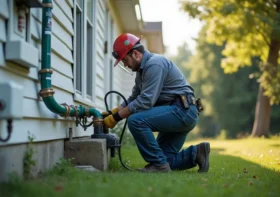Essential Insights To Know Before Taking On A House Painting Project

Painting a house is one of the most effective ways to refresh its appearance, protect surfaces, and add value. Whether you’re updating interior walls for a modern look or giving the exterior a much-needed facelift, painting is both a practical and aesthetic investment. Many homeowners underestimate the planning and preparation required for a successful project.
Before picking up a brush, it’s important to understand the key considerations that influence outcomes, everything from budget and color choices to surface preparation and long-term maintenance. A well-executed painting project can last years and enhance your property’s curb appeal, while a poorly managed one can lead to frustration and unexpected expenses.
Contents
Budgeting and Financial Considerations
One of the first aspects homeowners should address is the financial side of painting. While it may seem like a straightforward task, costs can vary dramatically depending on the scope of the project, the size of the home, and the type of finishes you select.
Materials, labor, and prep work all add up quickly. For exterior jobs, additional expenses such as scaffolding or weatherproofing compounds might be necessary, while interior projects could involve patching drywall or replacing trim.
Homeowners often search for guidance on the cost to paint a house, and for good reason. Professional painters may charge per square foot, by the hour, or provide a flat project fee. DIY approaches may seem cheaper, but equipment rentals, primer, brushes, rollers, and time commitment can offset initial savings.
To avoid surprises, it’s wise to get multiple quotes from contractors and factor in contingencies for unexpected repairs, like fixing water damage or addressing mold before painting begins.
Choosing the Right Paint and Finishes
Not all paints are created equal, and the type you choose will have a direct impact on both appearance and durability. For interiors, considerations include finish, matte, eggshell, satin, semi-gloss, or high-gloss, each with its own advantages. Matte hides imperfections well but is less washable, while satin and semi-gloss offer durability and easier cleaning for high-traffic areas like kitchens and hallways.
Exterior projects require paints designed to withstand weather conditions. UV-resistant formulas help protect colors from fading, while mildew-resistant coatings are ideal for damp climates. Investing in high-quality paint pays off in longevity, reducing the need for frequent touch-ups. Always consider the specific needs of each surface, whether it’s stucco, wood, or brick.
Preparation Is Half the Work
One of the most overlooked elements of painting is preparation. Even the most expensive paint won’t adhere properly to dirty or damaged surfaces. Interior walls may require cleaning, sanding, or patching holes, while exterior surfaces often need pressure washing and scraping old paint before priming.
Skipping prep work can lead to uneven coverage, peeling, or reduced paint life. A professional painter will typically dedicate a significant portion of the project timeline to preparation because it directly influences the final result. For DIYers, allocating sufficient time to clean and prime surfaces can be the difference between a polished, lasting finish and one that needs redoing in a year.
Timing and Weather Conditions
If you’re tackling an exterior painting project, timing is critical. Weather conditions such as humidity, temperature, and rain can all affect paint application and drying. Most professionals recommend painting when temperatures are mild, typically between 50 and 85 degrees Fahrenheit, and when rain isn’t in the forecast.
Interior projects benefit from proper timing. Adequate ventilation is necessary to help paint dry and reduce exposure to fumes. Planning your project around seasons where windows can be left open safely can improve air circulation and make the process more comfortable.
DIY vs. Hiring Professionals
Deciding whether to paint your house yourself or hire professionals depends on factors like budget, time, and skill level. DIY painting can be rewarding and cost-effective for smaller projects, but it often requires a steep learning curve. Missteps such as uneven coverage, drips, or incorrect prep can diminish results.
Hiring professionals brings expertise, efficiency, and often a warranty for the work performed. Contractors have access to commercial-grade tools and can handle challenges like tall exteriors, intricate trim, or specialty finishes more effectively. While it may come at a higher upfront cost, professional work often saves money in the long run by lasting longer and requiring fewer touch-ups.
Safety Considerations During Painting
Painting may seem like a relatively low-risk activity compared to larger home improvement projects, but safety should never be underestimated. Each phase of the process, from preparation to cleanup, presents its own hazards, and taking precautions can prevent accidents and protect both your health and property.
For exterior projects, working at heights is one of the biggest risks. Ladders and scaffolding present fall hazards, particularly on multi-story homes where the potential for serious injury is higher. Ensuring ladders are set on level, stable ground, securing them properly, and following the “three points of contact” rule (two hands and one foot or two feet and one hand always on the ladder) are critical practices.
When scaffolding is used, guardrails, toe boards, and proper assembly reduce risks significantly. It’s important to avoid working at heights in windy or wet conditions, as slick surfaces and strong gusts can make climbing hazardous.
Long-Term Maintenance and Care
Completing the painting project is only the beginning of protecting your investment. A fresh coat of paint enhances both aesthetics and durability, but its longevity depends heavily on consistent maintenance. Without proper care, even the best paint job can deteriorate faster than expected, leading to higher costs and frustration down the line. Establishing a routine for upkeep ensures that your home continues to look its best for years to come.
For interiors, maintenance often starts with cleaning. Walls, in high-traffic areas like hallways, kitchens, and children’s bedrooms, can accumulate fingerprints, dust, and grease. Using a soft cloth or sponge with mild soap and water can help maintain the vibrancy of the paint without causing damage. Glossy and satin finishes are easier to clean, while flat or matte finishes may require more delicate care to avoid leaving marks. Spot cleaning small stains as soon as they appear prevents discoloration and prolongs the life of your paint.
Taking on a house painting project involves much more than picking out colors and buying brushes. From budgeting and choosing the right paint to understanding prep work, timing, and safety considerations, thoughtful planning makes the difference between a lasting, polished result and a frustrating experience.
Whether you decide to go the DIY route or hire professionals, being informed about costs, techniques, and long-term care ensures your project delivers value for years to come. By approaching house painting with preparation and insight, you transform it from a daunting task into an investment that enhances comfort, beauty, and property value.



